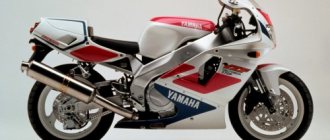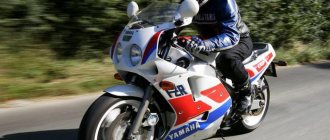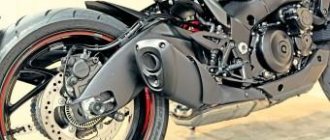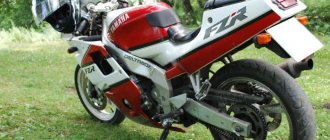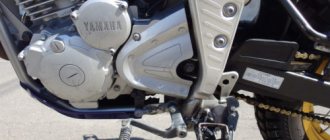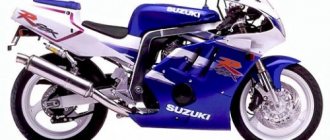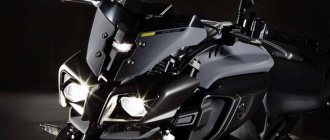| Yamaha FZR250 (1987) | Yamaha FZR250 (1987) | |
| Yamaha FZR250 (1988) | Yamaha FZR250 (1988) | Yamaha FZR250 (1988) |
| Yamaha FZR250R (1990) | Yamaha FZR250R (1990) | |
| Yamaha FZR250R (1991) | Yamaha FZR250R (1991) | |
| Yamaha FZR250R (1993) | Yamaha FZR250R (1993) | |
| Yamaha FZR250R (1994) |
Yamaha FZR 250 sports motorcycle model
was first introduced in 1986 (model year 1987) and was intended for the domestic Japanese market. The motorcycle was a junior model in the FZR sports line, and at that time it was quite advanced - the highly accelerated 4-cylinder in-line Genesis engine produced 45 hp. power and accelerated the motorcycle to 180 km/h. Since 1988, the Yamaha FZR 250 has been equipped with the EXUP system - an electric valve in the exhaust pipe that changes the exhaust cross-section depending on engine speed. Since 1989, the motorcycle has received a major update - an aluminum Deltabox frame, an aluminum swingarm, a new front fork, new front brakes, retuned suspensions, a 14-cylinder fuel tank and, most importantly, changes to the engine - the engine has become easier to spin, delivering maximum power at 16,000 rpm, tachometer is marked up to 21,000 rpm.
In 1993, due to changes in Japanese legislation, the engine was “strangled” to 40 hp, and in 1994 the model was finally discontinued. The subsequent refusal of the entire Japanese “four” from small-capacity, highly-powered 4-cylinder models was associated, first of all, with their low service life, which could be many times inferior to even 400 cc motorcycles. In addition, the production of such motorcycles was quite expensive, since parts and technical solutions used on older versions (Deltabox, EXUP, etc.) were often used.
Yamaha FZR series lineup:
- Yamaha FZR250
- Yamaha FZR400
- Yamaha FZR600
- Yamaha FZR750
- Yamaha FZR1000
The main competitors of the Yamaha FZR250 in the class:
- Honda CBR250RR
- Kawasaki ZXR250
- Suzuki GSX-R250
Brief history of the model
- 1986-1987 - start of production of Yamaha FZR 250.
Model:
Yamaha FZR 250 (Japan).
Factory designation:
2KR0.
- 1988 - the model is equipped with the EXUP system, receives minor changes in the design of the rear suspension, an increase in the front suspension travel to 120 mm, and the height of the footpegs increased by 6 mm.
Model:
Yamaha FZR 250 (Japan).
Factory designation:
3HX1.
- 1989 - restyling of the model. The motorcycle changes its name to Yamaha FZR250R, receives new engine components (maximum speed increases), a new fork of 38 mm (instead of 35 mm), 2-disc front brake with discs reduced to 282 mm (instead of 320 mm), reduced suspension travel (front: 117 mm instead of 120 mm, rear: 130 mm instead of 140 mm), increased fuel tank to 14 l (instead of 12 l), increased rear tire width (130 mm instead of 120 mm) and reduced seat height to 735 mm ( instead of 750 mm).
Model:
Yamaha FZR 250 R (Japan).
Factory designation:
3LN1.
- 1990 - minor changes regarding headlights, carburetors and muffler design.
Model:
Yamaha FZR 250 R (Japan).
Factory designation:
3LN3.
- 1991 - no significant changes.
Model:
Yamaha FZR 250 R (Japan).
Factory designation:
3LN5.
- 1992 - model not produced.
- 1993 - Due to changes in Japanese legislation, the maximum power of the Yamaha FZR250R was reduced to 40 hp. (instead of 45 hp).
Model:
Yamaha FZR 250 R (Japan).
Factory designation:
3LN6.
- 1994 is the last year of production of the model.
Model:
Yamaha FZR 250 R (Japan).
Factory designation:
3LN7.
Differences between Yamaha YZ250FX and YZ250F
Well, first of all, the Yamaha YZ250FX's six-speed transmission differs from the YZ250F's five-speed in that the FX has a significantly lower first gear—the equivalent of adding seven teeth to the rear sprocket. Second gear on the FX is equivalent to adding three teeth. The third on the YZ250FX is close to the third on the YZ250F, the fourth is two teeth higher, the fifth is three teeth higher than the fifth on the YZ-F, and the sixth is 10 teeth higher than the sixth would be on the YZ250F. Overall, the YZ250FX transmission has a 25% wider range of gear ratios than the cross-country model.
The second difference between the Yamaha YZ250FX and the YZ250F is the motor mount. The engine housing is, of course, the same, but it is mounted differently in the frame. The lower motor mounts on the YZ250FX are stiffer than on the YZ250F because the FX suspensions are softer and the bike weighs more, so the frame will play harder.
Yamaha YZ250FX
Third, the suspension itself: the Kayaba SSS components themselves are the same, but have different internal tuning elements. The Cross Country model has a softer ride and fork spring rate has been reduced from 4.7N/mm to 4.6. The rear shock absorber is equipped with the same spring as on the cross version (56N/mm), but its valves are again softer. The YZ250FX is more comfortable and smoother on the ride, but less designed for fast and hard riding.
Another interesting difference is on the steering wheel. The map switch, which has two positions, on the cross-country YZ250F in the factory state does not change anything: in both positions the stock map is filled in, and the owner is asked to independently fill in the desired map (it is turned on by pressing the switch to the position with a blue light). You can upload one of the four available ones there, or create your own, and at the same time have the stock one on hand for comparison. The 2021 Yamaha YZ250FX has two different maps: when the light is off, a more responsive and torquey map is running, and if you press the button, the blue signal will light up and the ECU will switch to a smoother map. That is, without the light, the base map works, and with the light, a “rain” map with improved traction, relatively speaking, works.
In fact, the stock card holds up pretty well, given the lower gears of the FX, and it’s better to fill the “with fire” slot with an aggressive crossover card from the Power Tuner application.
The map switch works on the fly, allowing you to select the engine character while driving. This is very good when driving on rough terrain, when you may need a softer map on a rocky slope, or a more aggressive one on a long straight. But be careful when using this feature: the map switch is located next to the engine shutdown button next to the left grip.
And if even the aggressive map on the YZ250FX is not enough for you, consider this point: the muffler of the cross-country version has a restrictor and flute, which provide a softer response at lower and mid-range speeds. So an aftermarket or even a muffler from the cross version can solve the issue of improving gas response.
The braking system on the 2021 YZ250FX is also slightly different from its motocross counterpart: the rear disc is 5mm larger, 245 instead of 240mm, as on the older YZ250F. The front brake is the same and works very well, but the rear brake on the XC is quite grippy and poorly modulated, especially on long, twisty descents.
Yamaha YZ250FX
The volume of the fuel tank of the Yamaha YZ250FX 2021 is a little over 8 liters, while the cross version has 6 liters. For comparison, the KTM 250XCF holds 8.5 liters, the Kawasaki KX250X 6.2 liters, the Honda CRF250RX 8.5 liters, the TM EN250 FI 9.5 liters and the GasGas EX250 8.5 liters. Beta, Suzuki and Husqvarna have not released any 250cc XCs for 2021.
It is worth considering that the 8.1 liters of the Yamaha YZ250FX do not provide the largest power reserve, so you should not deviate too far from the beaten path, and sometimes it is better to return than to ride at random when there is about half a tank left. By the way, the low fuel indicator lights up when there are about 2 liters left in the tank.
As for the tank itself, manufacturers have different options for where to place additional fuel without increasing the size of the motorcycle or compromising its ergonomics. If we are talking about backbone frames like KTM, GasGas and Husqvarna, then the tank is located on the sides of the upper frame beam, and its volume can be increased by extending the tank downwards. On perimeter frames, the tank is located between the frame side members, and you can add volume by expanding it in the radiator plastic area and making it higher in the neck area. In the case of the Yamaha, the engine faces rearward and the airbox is located at the front, so the lower part of the tank has been widened without compromising ergonomics.
As for the 18th rear wheel, to be honest, for most endurists and quite a significant portion of cross-sport riders, the difference between the 19th and 18th wheel is not that great. Yes, an 18th wheel on plump tires can additionally smooth out the load on the suspension and provide more grip, but in general the differences here are homeopathic. But the rubber in which the wheels are shod plays an important role.
For example, the Yamaha YZ250FX 2021 is shod from the factory with tires that are quite versatile in terms of terrain, but not very durable. When driving hard on a hard surface, they literally lose their checkers - and it is completely unclear what Yamaha is guided by when installing such rubber on “long-range” off-road motorcycles. However, the brand of stock tires depends on the market, and sometimes even on the dealer - just keep in mind that if you get a motorcycle from Dunlop, you will need to check the side lugs before each ride.
Another difference between the Cross Country FX and the Yamaha YZ250F is the weight. The cross-country version cannot be called light, but the cross-country version is 5 kg heavier. Likewise, the YZ250FX is 5 kilos heavier than the KTM 450SXF, Husqvarna FC 450 and GasGas MC 450.
The 2021 Yamaha YZ250FX is also about $200 more expensive than its motocross “base”. The price difference covers the six-speed split gearbox, larger tank, 18-inch rear wheel, side stand, different muffler, seal chain, low fuel level sensor and sump guard.
Yamaha YZ250FX 2021
Specifications
Technical characteristics of Yamaha FZR 250:
| Model | Yamaha FZR250 (FZR250R) |
| Motorcycle type | sport |
| Year of issue | 1986-1994 |
| Frame | steel tubular – FZR250 (1986-1988) aluminum Deltabox |
| engine's type | 4-cylinder, 4-stroke, in-line |
| Working volume | 249 cm³ |
| Bore/Stroke | 48.0 x 34.5 mm |
| Compression ratio | 12.0:1 |
| Cooling | liquid |
| Number of valves per cylinder | DOHC, 4 valves per cylinder |
| Fuel supply system | carburetor, 4x MIKUNI BDS26 |
| Ignition type | CDI |
| Maximum power | 45 hp (33.1 kW) at 14500 rpm – FZR250 (1986-1988) 45 hp (33.1 kW) at 16000 rpm - FZR250 (1989-1992) 40 hp — FZR250 (1993-1994) |
| Maximum torque | 24.5 Nm (2.5 kg*m) at 11,500 rpm – FZR250 (1986-1988) 24.5 Nm (2.5 kg*m) at 12,000 rpm – FZR250 (1989-1994) |
| Clutch | Multi-disc in oil bath, cable drive |
| Transmission | 6-speed |
| type of drive | chain |
| Front tire size | 100/80-17 |
| Rear tire size | 120/80-17 – FZR250 (1986-1988) 130/70-17 – FZR250 (1989-1994) |
| Front brakes | 1 disc, 320 mm, 4-piston caliper – FZR250 (1986-1988) 2 discs, 282 mm, 4-piston calipers – FZR250 (1989-1994) |
| Rear brakes | 1 disc 220 mm, 1-piston caliper |
| Front suspension | 35mm telescopic fork, 110mm travel – FZR250 (1986-1987) 35mm telescopic fork, 120mm travel – FZR250 (1988) 38mm telescopic fork, 117mm travel – FZR250 (1989-1994) |
| Rear suspension | pendulum with monoshock absorber, stroke - 140 mm - FZR250 (1986-1988) pendulum with monoshock absorber, stroke - 130 mm - FZR250 (1989-1994) |
| Length | 2010 mm – FZR250 (1986-1988) 1990 mm – FZR250 (1989-1994) |
| Width | 680 mm – FZR250 (1986-1988) 675 mm – FZR250 (1989-1994) |
| Height | 1120 mm |
| Wheelbase | 1375 mm |
| Seat height | 750 mm – FZR250 (1986-1988) 735 mm – FZR250 (1989-1994) |
| Minimum ground clearance (clearance) | 135 mm – FZR250 (1986-1988) 140 mm – FZR250 (1989-1994) |
| Acceleration 0-100 km/h (0-60 mph) | 5.0 sec. |
| Maximum speed | 180 km/h |
| Gas tank capacity | 12 l – FZR250 (1986-1988) 14 l – FZR250 (1989-1994) |
| Motorcycle weight (dry) | 140 kg – FZR250 (1986-1988) 141 kg – FZR250 (1989-1994) |
Advantages and disadvantages
The yz 250 model has a number of advantages due to which the demand for the motorcycle has not decreased over the years.
- Excellent dynamic characteristics.
- Small dimensions and weight.
- Power that few models can boast of.
- Comfortable fit.
- Reliable suspension with long travel.
- Stylish and laconic design.
Judging by the reviews of the owners, the Yamaha yz 250 has a minimum of shortcomings. For example, some motorcyclists note its uncertain behavior in sharp turns, the uncomfortable shape of the steering wheel, and also a rather weak front brake. Externally, the 250 cc model almost completely copies its more powerful brother - the YZ 450. The high cost (about 300 thousand rubles) and the lack of new models without mileage in Russia are also a disadvantage of the motorcycle. In general, the model may deserve the attention of lovers of expensive cross-country two-wheeled vehicles.
Reviews
Reviews about Yamaha FZR250:
Expand Collapse
I bought a Yamaha fzr250r motorcycle that I always dreamed of, after the Chinese it is comfort and strength. I don’t look for flaws in the motorcycle, I just enjoy the ride, and believe me, the Chinese breaks down 3 times more often than the Japanese and it doesn’t spoil my mood. I’m happy that I bought it a new and hopefully loyal friend...
FZR is my first Japanese motorcycle, I left quite good impressions, only the only problem on it is the crabs, the gasket on them, upon purchase, must be changed and it is advisable to synchronize it, since working in unison is much more pleasant and faster. I couldn’t find the original gaskets for the crabs, so after cleaning them I put them on sealant. I began to eat less gasoline. I changed the fuel more often and everything was fine. MotsYk was good to begin with and did not let us down.
I came across an FZR 250 R from 90 onwards. Damn, cool technique for beginners. I answer, I accelerated at 190 km/h, but that’s according to my mood. And the required 180 goes on any normal highway. I bought it on the Internet, incl. Before I go, I have a chat with him. In short, it’s very IMPORTANT: when buying, don’t get caught either. In this case, the reason was the carurators. The technology is far from new. The locking needles and their seats had been worn out, so it was simply filled with gasoline. I took off the fuel pump and... it drove off. Everything has become normal, but the consumption... in short, is very high. Now, in the off-season, I’ll find these same needles, everything will be OK. And one more thing: All such FZRs have weak forks, but this is more a feature of the motorcycle, and not a flaw. The rest is super technology.
Great bike for beginners. Excellent dynamics, good acceleration. Despite its 250cc, it’s just on the road!

